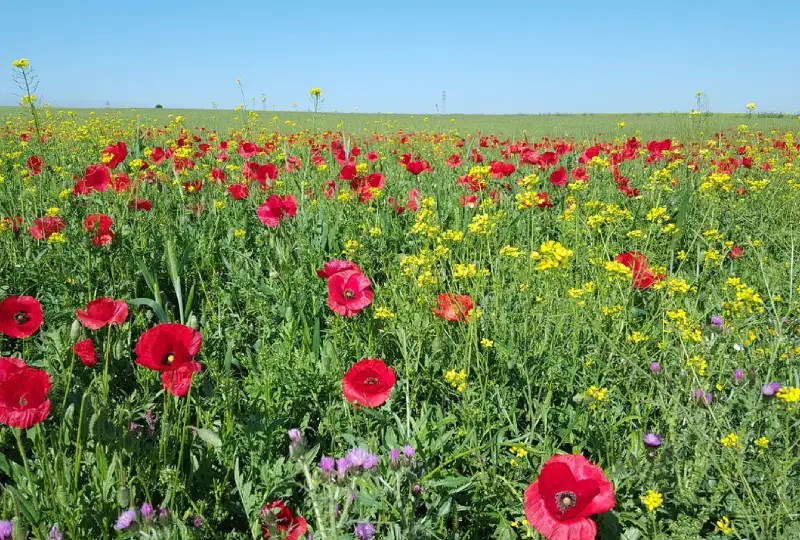Kitulo National Park Overview (Garden of God)
Kitulo National Park, fondly called the Garden of God, is a hidden gem located in the southern highlands of Tanzania. Covering approximately 412 square kilometers, it is renowned for its breathtaking montane grasslands, rolling hills, and expansive valleys blanketed with an extraordinary array of wildflowers. Unlike most Tanzanian parks, Kitulo is not dominated by large predators or big game; instead, it offers a unique ecosystem where botanical wonders, endemic plant species, and rare wildlife take center stage. This makes it a paradise for nature lovers, botanists, photographers, and travelers seeking a serene and colorful escape.
The park is particularly famous for its seasonal bloom, which occurs from December to March. During this period, the highlands are transformed into a vibrant carpet of lilies, orchids, and other indigenous flowering plants. Kitulo’s floral diversity is unmatched in Tanzania, with several species found nowhere else in the world. Beyond the flowers, the park is home to wildlife such as elands, zebras, bushbucks, and various bird species, including sunbirds and sun-loving endemics. The combination of rolling grasslands, scenic vistas, and endemic biodiversity gives Kitulo its unique identity as a botanical paradise.
Kitulo National Park is also an excellent destination for eco-tourism and hiking. Its network of trails offers panoramic views of the highlands, valleys, and neighboring mountains. Visitors can enjoy peaceful walks through meadows, observe rare wildlife, and immerse themselves in local culture by visiting surrounding villages. The park’s relatively low visitor numbers ensure a quiet, intimate experience, allowing travelers to fully appreciate the serene beauty and ecological significance of this remarkable highland landscape.
Where is Kitulo National Park located?
Kitulo National Park is situated in the southern highlands of Tanzania, spanning parts of the Njombe and Mbeya regions. The park lies approximately 360 kilometers southwest of Iringa and can be accessed via road from Iringa town or Mbeya. Its highland location, at altitudes ranging from 2,100 to 2,600 meters, provides a cool climate and lush vegetation that distinguishes it from Tanzania’s lowland savannah parks.
What makes Kitulo National Park unique?
Kitulo is unique for its floral diversity and montane grasslands rather than big game. Known as the “Garden of God,” the park hosts thousands of wildflower species, including numerous orchids and lilies endemic to the highlands. Its high-altitude grasslands and valleys provide habitats for rare mammals, birds, and insects, offering an ecological experience that is different from the traditional safari parks. Kitulo is also a hotspot for scientific research, especially in botany and conservation biology, due to its exceptional plant biodiversity.
What animals can be seen in Kitulo National Park?
While Kitulo is not a big-game park, it is home to several interesting mammals, including elands, zebras, bushbucks, and smaller antelope species. Primates such as vervet monkeys may occasionally be spotted, and the park supports a wide variety of birds, including endemic and highland species like sunbirds, weavers, and raptors. Insects, butterflies, and other invertebrates thrive among the wildflowers, making the park a rich site for nature enthusiasts and wildlife observers.
When is the best time to visit Kitulo National Park?
The best time to visit Kitulo is during the flowering season, which occurs from December to March. During these months, the highlands are transformed into a vibrant mosaic of colors, with lilies, orchids, and other indigenous blooms at their peak. The dry season, from June to October, offers cooler temperatures and clearer skies, which are ideal for hiking and panoramic photography. However, the park’s main attraction remains the floral spectacle, making the wet season the most visually rewarding period.
How can travelers access Kitulo National Park?
Kitulo is accessible by road from nearby towns such as Iringa, Mbeya, or Njombe. The journey usually requires a 4×4 vehicle due to the park’s highland terrain, especially during the rainy season. Travelers can combine a visit to Kitulo with a trip to other southern Tanzania destinations, such as Ruaha National Park or Udzungwa Mountains National Park, for a more diverse safari and nature experience.
What activities are available in Kitulo National Park?
The main activities in Kitulo revolve around hiking, botanical exploration, and wildlife observation. Trails lead visitors through rolling grasslands, wildflower meadows, and scenic valleys, offering opportunities for photography, birdwatching, and plant identification. Eco-tourism experiences, including guided walks and visits to local communities, provide insight into conservation efforts and highland culture. The park’s peaceful environment also makes it ideal for meditation, nature journaling, and wildlife photography.
Where can travelers stay in Kitulo National Park?
Accommodation near Kitulo is primarily composed of eco-lodges, guesthouses, and community-run campsites. These lodgings offer easy access to park trails and often provide breathtaking views of the highlands and valleys. While facilities are more modest than in Tanzania’s northern safari parks, they provide a comfortable base for nature-focused travelers who want to explore Kitulo’s unique floral landscapes and wildlife.
How does Kitulo compare to other national parks in Tanzania?
Kitulo is unlike Tanzania’s typical safari parks, which focus on large mammals and predator-prey interactions. Its emphasis is on highland flora, endemic species, and montane ecosystems. While parks like Serengeti, Ruaha, and Mikumi are ideal for classic savannah safaris, Kitulo offers a serene, off-the-beaten-path experience that appeals to botanists, hikers, and eco-tourists. Its unique combination of wildflowers, rolling grasslands, and endemic species makes it a must-see destination for those looking for a peaceful and visually stunning nature retreat.
Is Kitulo National Park safe for visitors?
Yes, Kitulo is safe for travelers. Visitors are encouraged to stay on designated trails, respect wildlife, and follow guidance from park rangers. The park’s low visitor numbers and community-managed initiatives contribute to a secure and tranquil experience, allowing guests to enjoy the natural beauty and biodiversity of the highlands without concern.

